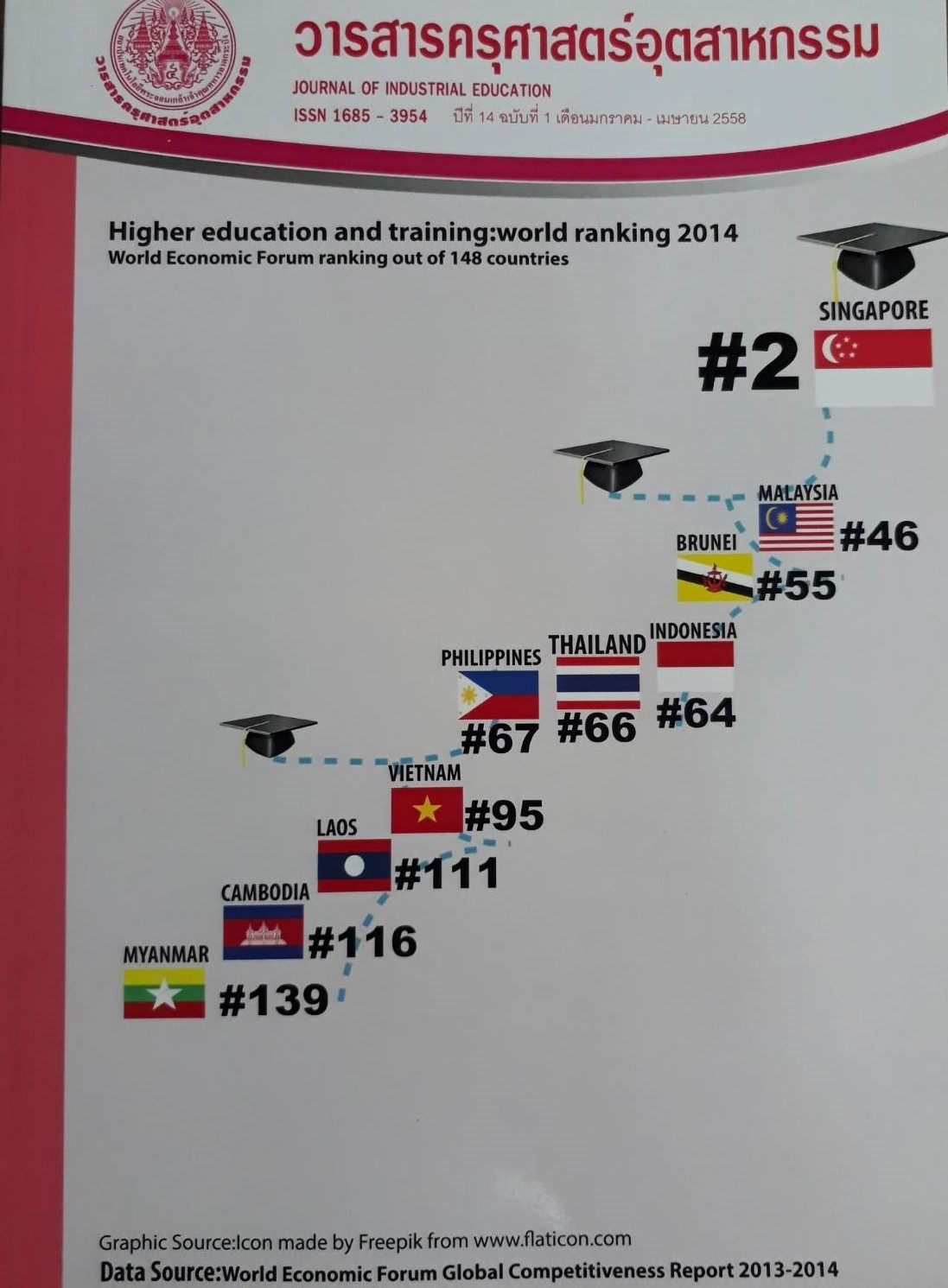Web-Based Instruction for Review on Knot Tying and Lashing According
Main Article Content
Abstract
The purposes of this research were to develop and determine the quality and efficiency, the learning Further achievement was compare between pre-test and post-test. wit learned by the web base instruction for review on components of computer system. The research samples were 40 first Matthayomsuksa I students studying in the first semester of the academic year 2013 at Tassaban 2 “Wipatsuksa” School, Surin Municipality. The samples were selected by cluster sampling methods. They were divided into 2 groups. The first group consists 20 students for finding efficiency and the second were 20 students for learning achievement comparison.
The research instruments were the web base instruction for review on knot tying and lashing according and the achievement test was 30 items test with 3.67 – 5.00 IOC, 0.20 – 0.80 difficulty degree, 0.20 – 0.80 discrimination degree and 0.87 reliability coefficient and analyzed by using t-test for dependent samples.
The results of this research were as the followings 1)the development quality of the web base instruction for review on components of computer system in terms of the content and the media production technique was at good level x̄ = 4.48, S = 0.36 and x̄ = 4.19, S = 0.40 respectively, 2) efficiency was at 80.45/87.17, and 3) post – achievement scores after studying the review of web base instruction on knot tying and lashing according were higher than the pre-test scores at 0.05 significant level. Accordingly, the results were consistent with the hypotheses.
Article Details
"The opinions and contents including the words in papers are responsibility by the authors."
"ข้อคิดเห็น เนื้อหา รวมทั้งการใช้ภาษาในบทความถือเป็นความรับผิดชอบของผู้เขียน"
References
[2] ไพโรจน์ ตีรรธนากุล. 2546. การออกแบบและการผลิตบทเรียนคอมพิวเตอร์ช่วยสอนสำหรับ e – learning. กรุงเทพฯ: ศูนย์สื่อเสริมกรุงเทพ.
[3] ชัยยงค์ พรหมวงศ์. 2545. เอกสารการสอนชุดวิชาเทคโนโลยีและสื่อสารการศึกษา หน่วยที่ 8 - 15. พิมพ์ครั้งที่ 20. กรุงเทพฯ : มหาวิทยาลัยสุโขทัยธรรมาธิราช.
[4] Bloom, Benjamin A. 1956. Taxonomy of Education Objective Handbook I : Cognitive Domain. New York : David Mc Kay Company.
[5] ล้วน สายยศ และอังคณา สายยศ. 2538. เทคนิคการวิจัยทางการศึกษา. กรุงเทพฯ: สุวีรียาสาส์น.
[6] พรรณี ลีกิจวัฒนะ. 2551. วิธีการวิจัยทางการศึกษา. พิมพ์ครั้งที่ 3. กรุงเทพฯ: คณะครุศาสตร์อุตสาหกรรม สถาบันเทคโนโลยีพระจอมเกล้าเจ้าคุณทหารลาดกระบัง.
[7] ชัยยงค์ พรหมวงศ์. 2542. เอกสารการสอนชุดวิชาประสบการณ์วิชาชีพครูหน่วยที่ 7-15. พิมพ์ครั้งที่ 101. นนทบุรี: มหาวิทยาลัยสุโขทัยธรรมมาธิราช
[8] บุญชม ศรีสะอาด. 2545. วิธีการสร้างสถิติสำหรับการวิจัย. พิมพ์ครั้งที่ 6. กรุงเทพฯ : สุวีริยาสาร์น.
[9] จิรวัฒน์ นนตระอุดร พรรณี ลีกิจวัฒนะและ พีระวุฒิ สุวรรณจันทร์. 2554. บทเรียนผ่าน เครือข่ายอินเทอร์เน็ตเพื่อการทบทวน เรื่องการใช้งาน ระบบปฏิบัติการลีนุกซ์เบื้องต้น วิชาไมโครคอมพิวเตอร์ และการใช้งาน 1 สำหรับนักเรียนระดับประกาศนียบัตร วิชาชีพแผนกวิชาอิเลกทรอนิกส์วิทยาลัยเทคนิค สมุทรปราการ. วารสารครุศาสตร์อุตสาหกรรม, 11(1), น.172-179.
[10] ไพฑูรย์ ศรีฟ้า. 2544. การพัฒนาระบบการเรียน การสอนผ่านเครือข่ายคอมพิวเตอร์เพื่อโรงเรียนไทย. การศึกษาดุษฎีบัณฑิต สาขาเทคโนโลยีทางการศึกษา บัณฑิตวิทยาลัย มหาวิทยาลัยศรีนครินทรวิโรฒ.
[11] บัญชา ปัญโญ. 2552. การพัฒนาบทเรียนบน เครือข่ายเรื่องการจัดโต๊ะหมู่บูชาชั้นมัธยมศึกษาปีที่ 1. ครุศาสตรมหาบัณฑิต (ค.ม.) สาขาคอมพิวเตอร์ศึกษา บัณฑิตวิทยาลัย มหาวิทยาลัยราชภัฏมหาสารคาม.
[12] อรญา จำเริญศรี พรรณี ลีกิจวัฒนะและ พีระวุฒิ สุวรรณจันทร์. 2554. การพัฒนา บทเรียนผ่านเว็บเรื่ององค์ประกอบของระบบ คอมพิวเตอร์ สำหรับนักเรียนชั้นมัธยมศึกษาปีที่ 1. วารสารครุศาสตร์อุตสาหกรรม, 11 (1), น.51-58.

